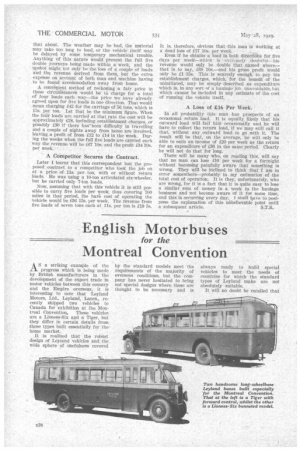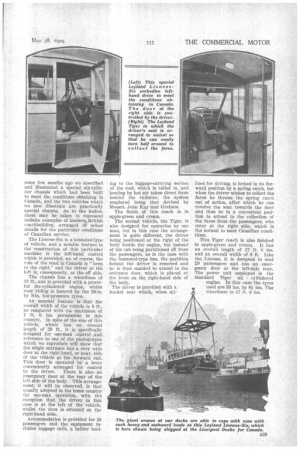English Motorbuses
Page 64

Page 65

If you've noticed an error in this article please click here to report it so we can fix it.
for the
Montreal Convention
S a striking example of the progress which is being made by British manufacturers in the development of the export trade in motor vehicles between this country and the Empire overseas, it is interesting to note that Leyland Motors, Ltd. Leyland, Lancs., recently shipi;ed two vehicles to Canada for exhibition at the Montreal Convention, These vehicles are a Lioness-Six and a Tiger, but they differ in certain details from those types built essentially for the, home market.
It is realized that the robust design of Leyland vehicles and the. wide sphere of usefulness covered
by the -standard models meet the requirements of the majority of overseas conditions, but the company has never hesitated to bring out special designs where these are thought to be necessary and is
always ready to build special vehicles to meet the needs of countries for which the standard types of Leyland make are not absolutely suitable.
It will no doubt be recalled that some few months ago we described and illustrated a special six-cylinder chassis which had been built to meet the conditions obtaining in Canada, and the two vehicles which we now illustrate are practically special chassis. As to the bodies, these may be taken to represent definite examples of inodern British coachbuilding, arranged in minor details for the particular conditions of Canadian service.
The Lioness-Six is a bonneted type of vehicle, and a notable feature in the 'construction of this particular machine is the left-hand control which is provided, as, of course, the rule of the road in Canada is "keep to the right," and the driver at the left is, consequently, at the off side.
The chassis has a wheelbase of 19 ft., and is provided with a powerful six-cylindered engine, whilst easy riding is insured by the 38-in. by 8-in, low-pressure tyres.
An unusual feature is• that the overall width of the vehicle is 8 ft., as compared with the maximum of 7 ft. 6 ins. permissible in this country. In spite of the size of this vehicle, which has an overall length of 29 ft., it is specifically designed for one-man control-sand .. reference to one of the photographs Which we reproduce will show that the single entrance has. a very wide door at the right-hand, or near, side of the vehicle at the forward end. This door is operated by a lever conveniently arranged for control by the driver. There is also an emergency door at the rear of the left side of the body. This arrangement, it will be observed, is that usually adopted in the home country for one-man operation, . with the exception that the driver in this case is at the left of the vehicle, whilst the door is situated on the right-hand side.
Accommodation is provided for 29 passengers and the equipment includes luggage rails, a ladder lead jug tO the luggage-carrying section of the roof, which is railed in, and heating by hot air taken direct from behind the radiator, the system employed being that devised by Messrs. John Kay. and Graham.
The finish of this coach is in apple-green and cream.
The second vehicle, the Tiger, is also designed for operation by one man, but in this ease the arrangement is quite different, the driver being positioned at the right of the body beside the engine, but instead of his cab being partitioned off from the passengers, as is the case with the bonneted-type bus, the partition behind the driver is removed and he is thus enabled to attend to the entrance door, which is placed at the front on the right-hand side of the body.
The driver is provided with a bucket seat which, when uti
lized for driving, is locked in its forward position by a spring catch, but when the driver wishes to collect the fares he throws the spring catch out of action, after which he can revolve the seat towards the door and thus be in a convenient position to attend to the collection of the fares from the passengers, who enter at the right side, which is the normal to meet Canadian conditions.
This Tiger coach is also finished in apple-green and cream. It has an overall length of 27 ft. 6 ins. and an overall width of 8 ft. Like the Lioness, it is designed to seat • 29 passengers and has an emergency door at the left-side rear. The power unit employed is the standard Tiger six cylindered engine. In this case the tyres used are 38 ins. by 8i ins. The . wheelbase is 17 ft. 6 ins.




















































































































